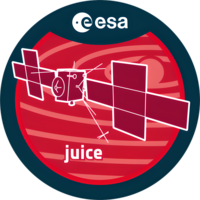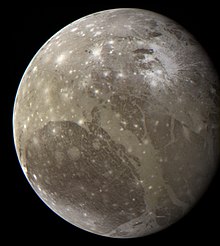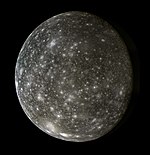Jupiter Icy Moons Explorer
 Artist's impression of the Juice spacecraft | |||||||||||||||||||||||
| Names | JUICE | ||||||||||||||||||||||
|---|---|---|---|---|---|---|---|---|---|---|---|---|---|---|---|---|---|---|---|---|---|---|---|
| Mission type | Planetary science | ||||||||||||||||||||||
| Operator | ESA | ||||||||||||||||||||||
| COSPAR ID | 2023-053A | ||||||||||||||||||||||
| SATCATno. | 56176 | ||||||||||||||||||||||
| Mission duration | Cruise phase: 8 years Science phase: 3.5 years Elapsed: 1 year, 3 months and 2 days | ||||||||||||||||||||||
| Spacecraft properties | |||||||||||||||||||||||
| Manufacturer | Airbus Defence and Space | ||||||||||||||||||||||
| Launch mass | 6,070 kg (13,380 lb)[1] | ||||||||||||||||||||||
| Dry mass | 2,420 kg (5,340 lb)[1] | ||||||||||||||||||||||
| Dimensions | 16.8 x 27.1 x 13.7 meters[1] | ||||||||||||||||||||||
| Power | 850 watts from asolar panel~85 m2(910 sq ft)[1] | ||||||||||||||||||||||
| Start of mission | |||||||||||||||||||||||
| Launch date | 14 April 2023 12:14:36 UTC[2] | ||||||||||||||||||||||
| Rocket | Ariane 5ECA | ||||||||||||||||||||||
| Launch site | Centre Spatial Guyanais,ELA-3 | ||||||||||||||||||||||
| Contractor | Arianespace | ||||||||||||||||||||||
| Flyby ofMoon | |||||||||||||||||||||||
| Closest approach | 19 August 2024 | ||||||||||||||||||||||
| Flyby of Earth | |||||||||||||||||||||||
| Closest approach | 20 August 2024 | ||||||||||||||||||||||
| Flyby ofVenus | |||||||||||||||||||||||
| Closest approach | 31 August 2025 | ||||||||||||||||||||||
| Flyby of Earth | |||||||||||||||||||||||
| Closest approach | 29 September 2026 | ||||||||||||||||||||||
| Flyby of Earth | |||||||||||||||||||||||
| Closest approach | 18 January 2029 | ||||||||||||||||||||||
| Jupiterorbiter | |||||||||||||||||||||||
| Orbital insertion | July 2031 (planned) | ||||||||||||||||||||||
| Orbital departure | December 2034 (planned) | ||||||||||||||||||||||
| Ganymedeorbiter | |||||||||||||||||||||||
| Orbital insertion | December 2034 (planned) | ||||||||||||||||||||||
| Orbital parameters | |||||||||||||||||||||||
| Periapsis altitude | 500 km (310 mi) | ||||||||||||||||||||||
| Apoapsis altitude | 500 km (310 mi) | ||||||||||||||||||||||
| |||||||||||||||||||||||
 Juice mission insignia | |||||||||||||||||||||||
TheJupiter Icy Moons Explorer(Juice,formerlyJUICE[3]) is aninterplanetary spacecrafton its way to orbit and study threeicy moonsofJupiter:Ganymede,Callisto,andEuropa.Theseplanetary-mass moonsare planned to be studied because they are thought to have beneath their frozen surfaces significant bodies of liquid water, which would make thempotentially habitableforextraterrestrial life.[4][5]
JUICE is the first interplanetaryspacecraft to the outer Solar System planetsnot launched by theUnited Statesand the first set to orbit a moon other than Earth'sMoon.Launched by theEuropean Space Agency(ESA), fromGuiana Space CentreinFrench Guianaon 14 April 2023, withAirbus Defence and Spaceas the main contractor,[6][7]it is expected to reach Jupiter in July 2031 after fourgravity assistsand eight years of travel.[8][9]In December 2034, the spacecraft will enter orbit around Ganymede for its close-up science mission.[8]Its period of operations will overlap withNASA'sEuropa Clippermission, launching in 2024.
Background[edit]
The mission, started as a reformulation of theJupiter Ganymede Orbiterproposal, which was to beESA's component of the cancelledEuropa Jupiter System Mission – Laplace(EJSM-Laplace).[10]It became a candidate for the first L-class mission (L1) of the ESACosmic VisionProgramme, and its selection was announced on 2 May 2012.[11]
In April 2012, JUICE was recommended over the proposedAdvanced Telescope for High Energy Astrophysics(ATHENA) X-ray telescope and agravitational waveobservatory (New Gravitational wave Observatory(NGO)).[12][13]
In July 2015,Airbus Defence and Spacewas selected as the prime contractor to design and build the probe, to be assembled inToulouse,France.[14]
By 2023, the mission was estimated to cost ESA 1.5 billion euros ($1.6 billion).[15]
Spacecraft[edit]
The mainspacecraft designdrivers are related to the large distance to the Sun, the use ofsolar power,and Jupiter's harsh radiation environment. The orbit insertions at Jupiter and Ganymede and the large number of flyby manoeuvres (more than 25gravity assists,and two Europa flybys) require the spacecraft to carry about 3,000 kg (6,600 lb) of chemical propellant.[16]The totaldelta-Vcapability of the spacecraft is about 2,700 m/s (6,000 mph).[17]
Juice has a fixed 2.5 meter diameter high-gain antenna and a steerable medium-gain antenna, bothX-andK-bandwill be used. Downlink rates of 2 Gb/day are possible with ground-based Deep Space Antennas. On-board data storage capability is 1.25 Tb.[1]

The Juice main engine is ahypergolicbi-propellant (mono-methyl hydrazineandmixed oxides of nitrogen) 425 N thruster. A 100 kg multilayer insulation provides thermal control. The spacecraft is 3-axis stabilized using momentum wheels. Radiation shielding is used to protect onboard electronics from the Jovian environment[1](the required radiation tolerance is 50kiloradat equipment level[17]).
The Juice science payload has a mass of 280 kg and includes the JANUS camera system, the MAJIS visible and infrared imaging spectrometer, the UVS ultraviolet imaging spectrograph, RIME radar sounder, GALA laser altimeter, SWI submillimetre wave instrument, J-MAG magnetometer, PEP particle and plasma package, RPWI radio and plasma wave investigation, 3GM radio science package, the PRIDE radio science instrument, and the RADEM radiation monitor. A 10.6-meter deployable boom will hold J-MAG and RPWI, a 16-meter-long deployable antenna will be used for RIME. Four 3-meter booms carry parts of the RPWI instrument. The other instruments are mounted on the spacecraft body, or for 3GM, within thespacecraft bus.[1]
Timeline[edit]
Launch[edit]

Juice was launched into space on 14 April 2023 from theGuiana Space Centreon anAriane 5rocket. This was the final launch of an ESA science mission using the Ariane 5 vehicle,[18]and was thesecond to last launch of the rocketoverall.[19]
The launch was originally scheduled for 13 April 2023, but due to poor weather the launch was postponed.[20]The next day a second launch attempt succeeded, with liftoff occurring at 12:14:36 UTC. After the spacecraft separated from the rocket, it established a successful radio signal connection with the ground at 13:04 UTC. Juice's solar arrays were deployed about half an hour later, prompting ESA to deem the launch a success.[18]
Trajectory[edit]
Following the launch, there will be multiple plannedgravity assiststo put Juice on a trajectory to Jupiter: a flyby of the Earth–Moon system in August 2024, Venus in August 2025, second flyby of Earth in September 2026, and a third and final flyby of Earth in January 2029.[8]
Juice will pass through theasteroid belttwice. A flyby of the asteroid223 Rosawas proposed to occur in October 2029, but was abandoned to save fuel for the primary Jovian mission.[21][22][23]
Gravity assists include:[24]
- Interplanetary transfer (Earth, Venus, Earth, Earth)[18]
- Jupiterorbit insertionand apocentre reduction with multiple Ganymede gravity assists
- Reduction of velocity with Ganymede–Callisto assists
- Increaseinclinationwith 10–12 Callisto gravity assists
Summary of intended Jupiter mission phases[edit]
The main characteristics of the Jupiter reference tour are summarised below (source: Table 5-2 of ESA/SRE(2014)1[17]). This scenario assumed an early June 2022 launch, however, thedelta-Vrequirements are representative due to the rather short, repetitive orbital configurations of Europa, Ganymede and Callisto.
| Event | Duration | Delta-Vnotes[17] |
|---|---|---|
| Jupiter orbit insertion:
When it arrives in the Jovian system in July 2031,[8]Juice will first perform a 400 km (250 mi) Ganymede gravity assist flyby to reduce spacecraft velocity by ~300 m/s (670 mph), followed by ~900 m/s (2,000 mph) Jupiter orbit insertion engine burn ~7.5 hours later. Finally, a Perijove Raising Manoeuvre (PRM) burn atapoapsiswill raise theperiapsisof JUICE's initial 13x243 Jovian radii elongated orbit to match that of Ganymede (15 Rj). |
186 days | 952 m/s (2,130 mph). |
| 2nd Ganymede flyby to initial encounter with Callisto:2nd, 3rd and 4th Ganymede flyby to reduce the orbital period and inclination of JUICE's orbit, followed by 1st flyby of Callisto. | 193 days | 27 m/s (60 mph). |
| Europa phase:Starting in July 2032,[8]there will be two <400 km (250 mi) flybys of Europa followed by another Callisto flyby. The brief Europa encounters (during which the probe is expected to sustain a third of its lifetime radiation exposure[25]) are planned such that the radiation exposure is as low as possible, first by encountering Europa at perijove (i.e. the spacecraft's perijove is equal to Europa’s orbital radius), and second by having only one low perijove passage per Europa flyby. | 35 days | 30 m/s (67 mph). |
| Inclined phase:~6 further flybys of Callisto and Ganymede to temporarily increase the orbital inclination to 22 degrees. This will allow investigating Jupiter's polar regions andJupiter's magnetosphere[8]at the maximum inclination over a four-month period. | 208 days | 13 m/s (29 mph). |
| Transfer to Ganymede:A series of Callisto and Ganymede gravity assists will be performed to gradually reduce JUICE's speed by 1,600 m/s (3,600 mph). Finally, a series of distant ~45,000 km (28,000 mi) flybys of the far side of Ganymede (near the Jupiter-Ganymede-L2Lagrange point) will further reduce the required orbital insertion delta-V by 500 m/s (1,100 mph). | 353 days | 60 m/s (130 mph). |
| Ganymede orbital phase:In December 2034,[8]Juice will enter an initial 12-hour polar orbit around Ganymede after performing a 185 m/s (410 mph) delta-V braking burn. Jupiter gravitational perturbations will gradually reduce the minimum orbital altitude to 500 km (310 mi) after ~100 days. The spacecraft will then perform two major engine firings to enter a nearly circular 500 km (310 mi) polar orbit, for a further six months of observations (e.g. Ganymede's composition andmagnetosphere). At the end of 2035,[8]Jupiter perturbations will cause JUICE to impact on Ganymede within weeks as the spacecraft runs out of propellant. | 284 days | 614 m/s (1,370 mph). |
| Full tour(Jupiter orbit insertion to end of mission) | 1259 days | 1,696 m/s (3,790 mph). |
Science objectives[edit]


The JUICE orbiter will perform detailed investigations onGanymedeand evaluate itspotential to support life.Investigations ofEuropaandCallistowill complete a comparative picture of theseGalilean moons.[26]The three moons are thought to harbour internalliquid water oceans,and so are central to understanding thehabitabilityof icy worlds.
The main science objectives for Ganymede, and to a lesser extent for Callisto, are:[26]
- Characterization of the ocean layers and detection of putative subsurface water reservoirs
- Topographical, geological and compositionalmapping of the surface
- Study of the physical properties of the icy crusts
- Characterization of the internal mass distribution, dynamics and evolution of the interiors
- Investigation of Ganymede'stenuous atmosphere
- Study of Ganymede's intrinsicmagnetic fieldand its interactions with theJovian magnetosphere.
For Europa, the focus is on the chemistry essential to life, includingorganic molecules,and on understanding the formation of surface features and the composition of the non-water-ice material. Furthermore, JUICE will provide the first subsurface sounding of the moon, including the first determination of the minimal thickness of the icy crust over the most recently volcanically active regions.
More distant spatially resolved observations will also be carried out for several minor irregular satellites and the volcanically active moonIo.
Science instruments[edit]


On 21 February 2013, after a competition, 11 science instruments were selected by ESA, which were developed by science and engineering teams from all over Europe, with participation from the US.[27][28][29][30]Japan also contributed several components for SWI, RPWI, GALA, PEP, JANUS and J-MAG instruments, and will facilitate testing.[31][32][33]
- Jovis, Amorum ac Natorum Undique Scrutator (JANUS)
The name isLatinfor "comprehensive observation of Jupiter, his love affairs and descendants."[34]It is a camera system to image Ganymede and interesting parts of the surface of Callisto at better than 400 m/pixel (resolution limited by mission data volume). Selected targets will be investigated in high-resolution with a spatial resolution from 25 m/pixel down to 2.4 m/pixel with a 1.3° field of view. The camera system has 13 panchromatic, broad and narrow-band filters in the 0.36 μm to 1.1 μm range, and provides stereo imaging capabilities.JANUSwill also allow relating spectral, laser and radar measurements to geomorphology and thus will provide the overall geological context.
- Moons and Jupiter Imaging Spectrometer (MAJIS)
A visible and infraredimaging spectrographoperating from 400 nm to 5.70 μm, withspectral resolutionof 3–7 nm, that will observe tropospheric cloud features and minor gas species on Jupiter and will investigate the composition of ices and minerals on the surfaces of the icy moons. The spatial resolution will be down to 75 m (246 ft) on Ganymede and about 100 km (62 mi) on Jupiter.
- UV Imaging Spectrograph (UVS)
Animaging spectrographoperating in the wavelength range 55–210 nm with spectral resolution of <0.6 nm that will characteriseexospheresandauroraeof the icy moons, including plume searches on Europa, and study the Jovian upper atmosphere and aurorae. Resolution up to 500 m (1,600 ft) observing Ganymede and up to 250 km (160 mi) observing Jupiter.
- Sub-millimeter Wave Instrument (SWI)
Aspectrometerusing a 30 cm (12 in) antenna and working in 1080–1275GHzand 530–601 GHz with spectral resolving power of ~107that will study Jupiter's stratosphere and troposphere, and the exospheres and surfaces of the icy moons.
- Ganymede Laser Altimeter (GALA)
Alaser altimeterwith a 20 m (66 ft) spot size and 10 cm (3.9 in) vertical resolution at 200 km (120 mi) intended for studying topography of icy moons and tidal deformations of Ganymede.
- Radar for Icy Moons Exploration (RIME)

Anice-penetrating radarworking at frequency of 9 MHz (1 and 3 MHz bandwidth) emitted by a 16 m (52 ft) antenna; will be used to study the subsurface structure of Jovian moons down to 9 km (5.6 mi) depth with vertical resolution up to 30 m (98 ft) in ice.
During post-launch commissioning of the spacecraft, the RIME antenna failed to properly deploy from its mounting bracket.[35]After several weeks of attempts to free the instrument, it was successfully deployed on 12 May of the same year.[36]
- JUICE-Magnetometer (J-MAG)

JUICE will study the subsurface oceans of the icy moons and the interaction of Jovian magnetic field with themagnetic field of Ganymedeusing a sensitivemagnetometer.
- Particle Environment Package (PEP)
A suite of six sensors to study themagnetosphere of Jupiterand its interactions with the Jovian moons.PEPwill measure positive and negative ions, electrons, exospheric neutral gas, thermalplasmaandenergetic neutral atomspresent in all domains of the Jupiter system from 1meVto 1MeVenergy.
- Radio and Plasma Wave Investigation (RPWI)
RPWI will characterise theplasmaenvironment and radio emissions around the spacecraft, it is composed of four experiments: GANDALF, MIME, FRODO and JENRAGE.RPWIwill use fourLangmuir probes,each one mounted at the end of its own dedicated boom and sensitive up to 1.6 MHz, to characterize plasma, and receivers in the frequency range 80 kHz to 45 MHz to measure radio emissions.[37]This scientific instrument is somewhat notable for usingSonic the Hedgehogas part of its logo.[38][39]
- Gravity and Geophysics of Jupiter and Galilean Moons (3GM)
3GM is a radio science package comprising aKatransponder and an ultrastableoscillator.[40]3GM will be used to study the gravity field – up to degree 10 – at Ganymede and the extent of internal oceans on the icy moons, and to investigate the structure of the neutral atmospheres and ionospheres of Jupiter (0.1 – 800 mbar) and its moons. 3GM carries Israeli-builtatomic clock"that will measure tiny vacillations in a radio beam".[41][42]
- Planetary Radio Interferometer and Doppler Experiment (PRIDE)
The experiment will generate specific signals transmitted by JUICE's antenna and received byvery-long-baseline interferometryto perform precision measurements of the gravity fields of Jupiter and its icy moons.
See also[edit]
- Exploration of Jupiter
- Europa Clipper– Planned NASA space mission to Jupiter
- Galileo– former Jupiter orbiter
- Juno– current Jupiter orbiter
- Tianwen 4– Planned Jupiter/Callisto orbiter
- Jupiter flybys:Pioneer 10/11;Voyager 1/2;Ulysses;Cassini–Huygens;New Horizons
- 17776,a speculative fiction work featuring a sapient JUICE
References[edit]
- ^abcdefg"NASA – NSSDCA – Spacecraft – Details".NASA Space Science Data Coordinated Archive.Archivedfrom the original on 10 November 2021.Retrieved16 April2023.
 This article incorporates text from this source, which is in thepublic domain.
This article incorporates text from this source, which is in thepublic domain.
- ^"European Space Agency: Blast off for Jupiter icy moons mission".BBC News.14 April 2023.Archivedfrom the original on 14 April 2023.Retrieved14 April2023.
- ^"Juice, exploring Jupiter's icy moons".The Planetary Society.Retrieved30 April2023.
- ^Clark, Stuart (5 March 2023)."'It's like finding needles in a haystack': the mission to discover if Jupiter's moons support life ".The Guardian.Archivedfrom the original on 7 March 2023.Retrieved7 March2023.
- ^"ESA—Selection of the L1 mission"(PDF).ESA.17 April 2012.Archived(PDF)from the original on 16 October 2015.Retrieved19 April2012.
- ^"ESA's Juice lifts off on quest to discover secrets of Jupiter's icy moons".ESA.Archivedfrom the original on 14 April 2023.Retrieved16 April2023.
- ^"JUICE. Searching for life on Jupiter's icy moons".airbus.27 October 2021.Archivedfrom the original on 13 April 2023.Retrieved16 April2023.
- ^abcdefgh"Juice's journey and Jupiter system tour".ESA.29 March 2022.Archivedfrom the original on 24 September 2022.Retrieved3 April2022.
- ^"JUpiter ICy moons Explorer (JUICE)".NASA Space Science Data Coordinated Archive.NASA. 28 October 2021.Archivedfrom the original on 10 November 2021.Retrieved10 November2021.
- ^"JUICE (JUpiter ICy moons Explorer): a European-led mission to the Jupiter system"(PDF).Copernicus.org.Archived(PDF)from the original on 21 November 2011.Retrieved8 August2011.
- ^Amos, Jonathan (2 May 2012)."ESA selects 1bn-euro Juice probe to Jupiter".BBC News.Archivedfrom the original on 11 May 2020.Retrieved20 June2018.
- ^Lakdawalla, Emily (18 April 2012)."JUICE: Europe's next mission to Jupiter?".The Planetary Society.Archivedfrom the original on 1 May 2012.Retrieved2 May2012.
- ^Amos, Jonathan (19 April 2012)."Disappointed astronomers battle on".BBC News.Archivedfrom the original on 18 June 2019.Retrieved20 June2018.
- ^"Preparing to build ESA's Jupiter mission".ESA Science & Technology.European Space Agency.17 July 2015.Archivedfrom the original on 2 October 2015.Retrieved28 October2015.
- ^Rainbow, Jason (20 January 2023)."Europe's Jupiter-bound JUICE spacecraft is ready for April launch".
- ^"JUICE—Spacecraft".ESA Science & Technology.European Space Agency.16 March 2012.Archivedfrom the original on 10 May 2013.Retrieved20 April2012.
- ^abcd"ESA/SRE(2014)1 JUICE definition study report (Red Book)".ESA.Retrieved1 May2024.
- ^abc"ESA's Juice lifts off on quest to discover secrets of Jupiter's icy moons".ESA.14 April 2023.Archivedfrom the original on 14 April 2023.Retrieved14 April2023.
- ^Foust, Jeff (14 April 2023)."Ariane 5 launches ESA's JUICE mission to Jupiter".SpaceNews.Retrieved18 April2023.
- ^@Arianespace (13 April 2023)."Today's Flight #VA260 has been delayed due to weather condition (risk of lightning) at the scheduled liftoff time from Europe's Spaceport in French Guiana. The Ariane 5 launch vehicle and its passenger JUICE are in stable and safe condition"(Tweet).Retrieved16 April2023– viaTwitter.
- ^Avdellidou, C.; Pajola, M.; Lucchetti, A.; Agostini, L.; Delbo, M.; Mazzotta Epifani, E.; Bourdelle De Micas, J.; Devogèle, M.; Fornasier, S.; Van Belle, G.; Bruot, N.; Dotto, E.; Ieva, S.; Cremonese, G.; Palumbo, P. (2021)."Characterisation of the main belt asteroid (223) Rosa"(PDF).Astronomy & Astrophysics.656:L18.Bibcode:2021A&A...656L..18A.doi:10.1051/0004-6361/202142600.S2CID244753425.
- ^Warren, Haygen (20 March 2023)."As launch approaches, JUICE project manager discusses trajectories and science".NASASpaceFlight.Archivedfrom the original on 12 April 2023.Retrieved12 April2023.
- ^European Space Agency [@ESA_JUICE] (14 December 2023)."🧃 Time for another visit to the #ESAJuice bar 😉 At 8⃣% of the way to Jupiter, we have an update on our journey. We had been considering slightly diverting Juice to visit an asteroid en route to #Jupiter. To maximise fuel for our main mission (the tour around the gas giant and its icy moons), we have decided against this asteroid flyby"(Tweet) – viaTwitter.
- ^"JUICE (JUpiter ICy moons Explorer)"(PDF).Universities Space Research Association.European Space Agency. March 2012.Archived(PDF)from the original on 9 January 2014.Retrieved18 July2013.
- ^"Jupiter's radiation belts – and how to survive them".esa.int.
- ^ab"JUICE—Science objectives".ESA Science & Technology.European Space Agency.16 March 2012.Archivedfrom the original on 8 June 2013.Retrieved20 April2012.
- ^"ESA chooses instruments for its Jupiter Icy Moon Explorer".ESA Science & Technology.ESA.21 February 2013.Archivedfrom the original on 1 November 2013.Retrieved17 June2013.
- ^"JUICE science payload".ESA Science & Technology.European Space Agency.7 March 2013.Archivedfrom the original on 22 April 2014.Retrieved24 March2014.
- ^"The JUICE Instruments".National Centre for Space Studies.11 November 2013.Archivedfrom the original on 24 March 2014.Retrieved24 March2014.
- ^"Jupiter Icy Moons Explorer (JUICE): Science objectives, mission and instruments"(PDF).Universities Space Research Association.45thLunar and Planetary Science Conference(2014).Archived(PDF)from the original on 24 March 2014.Retrieved24 March2014.
- ^"JUICE-JAPAN".JAXA.Archivedfrom the original on 14 July 2020.Retrieved14 July2020.
- ^Saito, Y.; Sasaki, S.; Kimura, J.; Tohara, K.; Fujimoto, M.; Sekine, Y. (1 December 2015)."Current Status of Japanese Participation to Jupiter Icy Moons Explorer" JUICE "".AGU Fall Meeting Abstracts.2015:P11B–2074.Bibcode:2015AGUFM.P11B2074S.Archivedfrom the original on 14 April 2023.Retrieved10 November2019.
- ^"Sao Mộc băng vệ tinh thăm tra vệ tinh JUICE – Nhật Bản が JUICE で mục chỉ すサイエンス"[Jupiter Ice Moon Exploration Satellite JUICE – Science that Japan is aiming for with JUICE](PDF).JAXA.Archived fromthe original(PDF)on 12 November 2019.Retrieved14 April2023.
- ^Köhler, Ulrich (December 2021)."Of Distant Moons and Oceans"(PDF).German Aerospace Center.pp. 34–37.Archived(PDF)from the original on 26 May 2022.Retrieved13 August2022.
- ^"Work continues to deploy Juice RIME antenna".esa.int.Retrieved5 May2023.
- ^"Juice's RIME antenna breaks free".esa.int.Retrieved12 May2023.
- ^"Payload - JUICE - Cosmos".cosmos.esa.int.Retrieved10 June2024.
- ^"Sao Mộc băng vệ tinh thăm tra cơ に chở khách の sóng điện quan trắc trang bị が “ソニック・ザ・ヘッジホッグ” と cộng に sao Mộc へ "[Radio observation equipment installed in the Jupiter ice satellite probe goes to Jupiter with 'Sonic the Hedgehog'].Tohoku University.Archivedfrom the original on 21 January 2023.Retrieved21 January2023.
- ^Plunkett, Luke (3 October 2019)."Actual Space Mission Picks Sonic The Hedgehog As An Official Mascot".Kotaku.Archivedfrom the original on 3 October 2019.Retrieved21 January2023.
- ^Shapira, Aviv; Stern, Avinoam; Prazot, Shemi; Mann, Rony; Barash, Yefim; Detoma, Edoardo; Levy, Benny (2016). "An Ultra Stable Oscillator for the 3GM experiment of the JUICE mission".2016 European Frequency and Time Forum (EFTF).pp. 1–5.doi:10.1109/EFTF.2016.7477766.ISBN978-1-5090-0720-2.S2CID2489857.
- ^"Israeli Instrument Bound for Jupiter - Weizmann Wonder Wander - News, Features and Discoveries".Weizmann Wonder Wander - News, Features and Discoveries from the Weizmann Institute of Science.7 January 2016.
- ^"ESA will launch JUICE to Jupiter, with Israeli technologies and scientific research".סוכנות החלל הישראלית.
External links[edit]
- ESA's JUICE page
- Future Planetary Exploration JUICE – Jupiter Ganymede Orbiter Revised Proposal
- Jupiter Icy Moons Explorer(2011)(OPAG October 2011 Presentations)
- JUICE (JUpiter ICy moons Explorer)(OPAG March 2012 Presentations)
- JUICE-JAPAN–JAXA
- JUICE–NASA
- JUICE article on eoPortal by ESA
- YouTube channelthe making of JUICE–ESA
- The making of Juice: the filmby ESA















